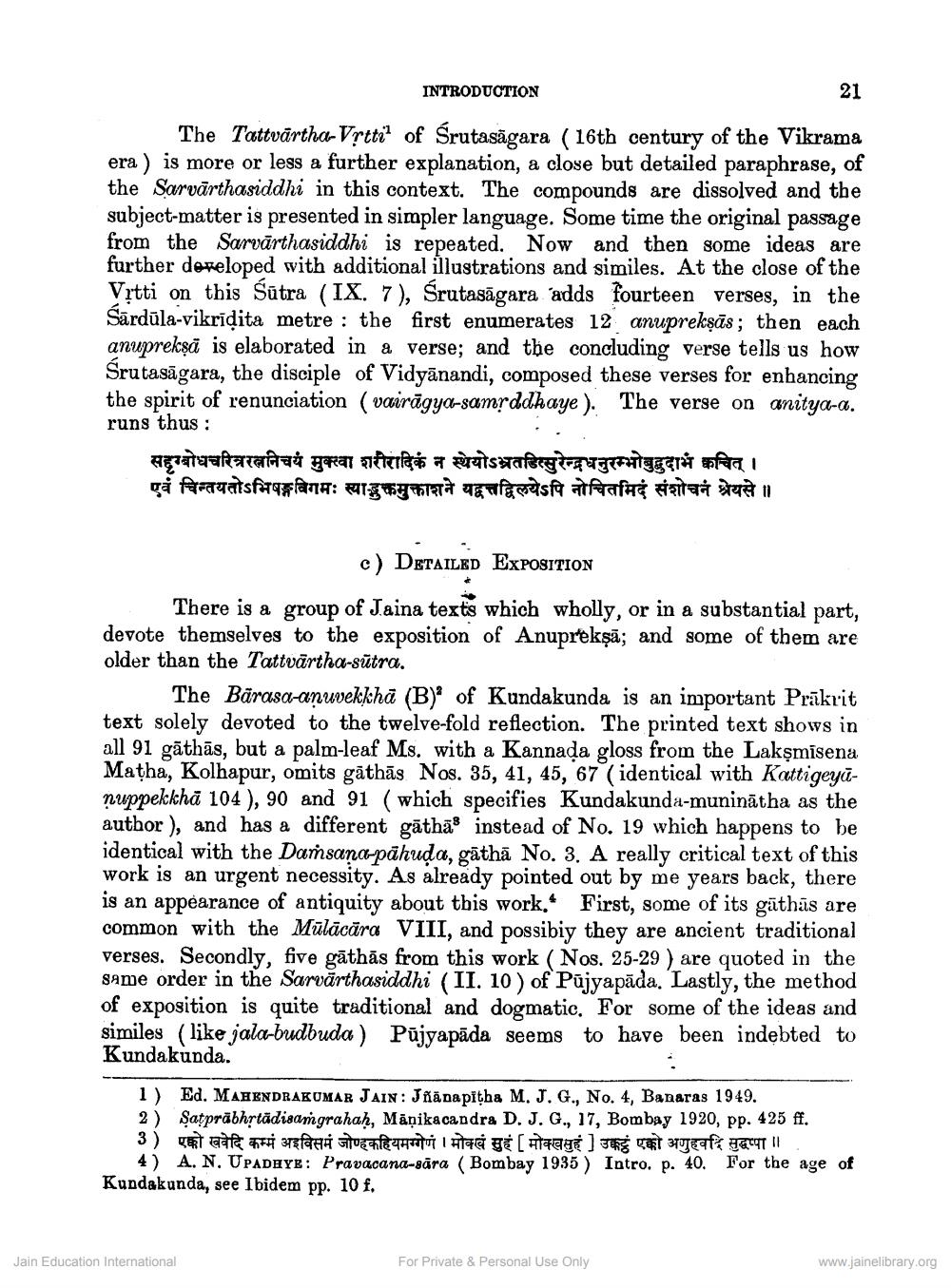________________
INTRODUCTION
21
The Tattvārtha-Vrtti" of Śrutasāgara (16th century of the Vikrama era) is more or less a further explanation, a close but detailed paraphrase, of the Sarvārthasiddhi in this context. The compounds are dissolved and the subject matter is presented in simpler language. Some time the original passage from the Sarvārthasiddhi is repeated. Now and then some ideas are further developed with additional illustrations and similes. At the close of the Vitti on this Sūtra (IX. 7), Śrutasāgara adds fourteen verses, in the Sārdüla-vikridita metre : the first enumerates 12 anuprekşās; then each anupreksa is elaborated in a verse; and the concluding verse tells us how Srutasāgara, the disciple of Vidyānandi, composed these verses for enhancing
pirit of renunciation (vairāgya-samrddhaye). The verse on anitya-a. runs thus :
सहरबोधचरित्ररत्ननिचयं मुक्त्वा शरीरादिकं न स्थेयोऽभ्रतडित्सुरेन्द्रधनुरम्भोबुद्धदाभ क्वचित् । एवं चिन्तयतोऽभिषङ्गविगमः स्याद्भूतमुक्ताशने यद्वत्तद्विलयेऽपि नोचितमिदं संशोचनं श्रेयसे ॥
c) DETAILED EXPOSITION There is a group of Jaina texts which wholly, or in a substantial part, devote themselves to the exposition of Anuprekşā; and some of them are older than the Tattvärtha-sūtra.
The Bärasa-anuvekkha (B) of Kundakunda is an important Prākrit text solely devoted to the twelve-fold reflection. The printed text shows in all 91 gāthās, but a palm-leaf Ms. with a Kannada gloss from the Lakşmisena Matha, Kolhapur, omits gāthās Nos. 35, 41, 45, 67 (identical with Kattigeyunuppekkhā 104 ), 90 and 91 (which specifies Kundakunda-muninātha as the author ), and has a different gāthās instead of No. 19 which happens to be identical with the Dañsana-pähuda, gāthā No. 3. A really critical text of this work is an urgent necessity. As already pointed out by me years back, there is an appearance of antiquity about this work. First, some of its gāthās are common with the Mülācāra VIII, and possibiy they are ancient traditional verses. Secondly, five gāthās from this work ( Nos. 25-29 ) are quoted in the same order in the Sarvärthasiddhi (II. 10 ) of Pūjyapāda. Lastly, the method of exposition is quite traditional and dogmatic. For some of the ideas and similes (like jala-budbuda ) Pūjyapāda seems to have been indebted to Kundakunda.
1) Ed. MAHENDRAKUMAR JAIN: Jñānapitha M. J. G., No. 4, Banaras 1949. 2) Satprābhrtādisangrahah, Māņika candra D. J. G., 17, Bombay 1920, pp. 425 ff. 3) एक्को खवेदि कम्मं अइविसमं जोण्हकहियमग्गेणं । मोक्खं सुहं [ मोक्खसुहं ] उक्कट्ठ एक्को अगुहवदि सुद्धप्पा ॥
4) A. N. UPADHYE: Pravacana-sāra (Bombay 1935 ) Intro. p. 40. For the age of Kundakunda, see Ibidem pp. 10 f.
Jain Education International
For Private & Personal Use Only
www.jainelibrary.org




